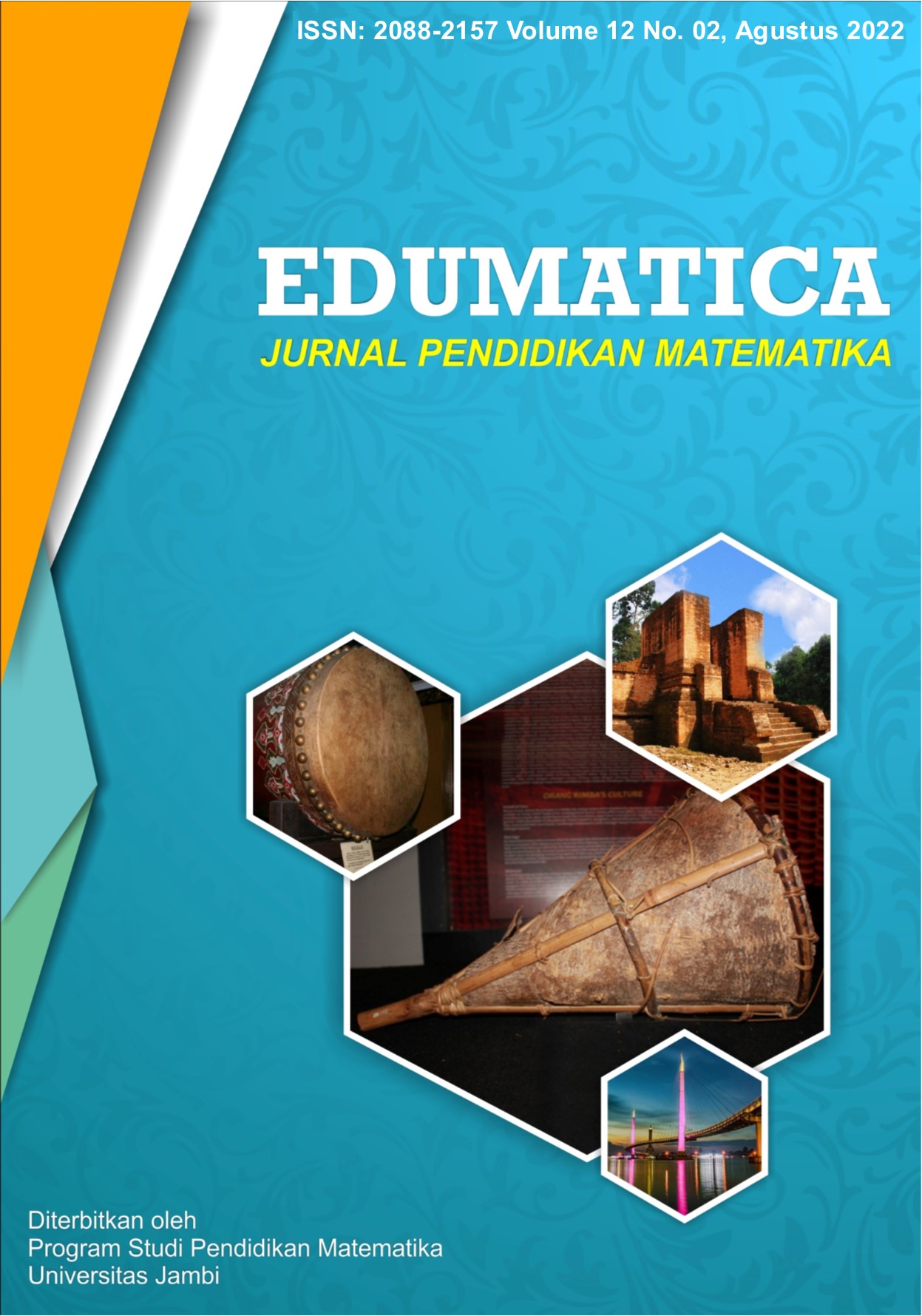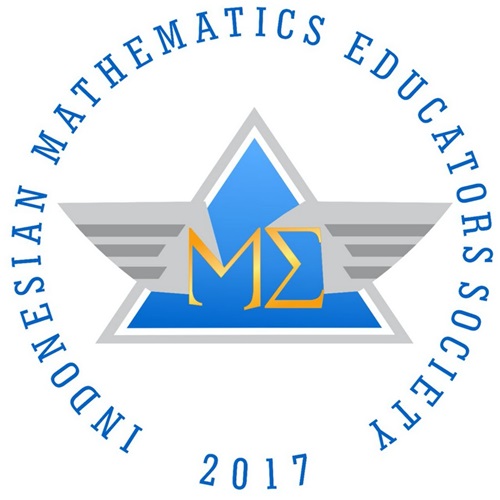New Normal Learning: Variations in Creative Thinking Ability at the Self-Regulated Learning Level of High School Students
DOI:
https://doi.org/10.22437/edumatica.v12i02.18908Keywords:
creative thinking ability, self-regulated learningAbstract
The focus of this research was to determine whether there were variations in the mathematics creative thinking abilities of students in class XI MIPA based on their level of self-regulated learning. A quantitative technique used in this research. This is an ex post facto research. This research included 159 students from MIPA class XI who completed a self-regulated learning questionnaire. The sample in this study was collected using the stratified random sampling approach, which was chosen based on high, moderate, and low levels of self-regulated learning. The sample for each level of self-regulated learning was determined using the sample-to-variable-ratio guidelines, which yielded up to 29 samples with a total of 87 students for each level. Data collection methods include self-regulated learning questionnaire and assessments of creative thinking abilities. The data analysis technique started with precondition tests, such as the normality test with the Kolmogorov-smirnov test and homogeneity test with the Barlett test, and then moved on to hypothesis testing with one-way ANOVA at a significance level of 5%, continued with post-ANOVA testing with the Scheffe test. Students with high self-regulated learning had higher creative thinking skills than students with moderate and low self-regulated learning, whereas students with moderate self-regulated learning had higher mathematical creative thinking skills than students with low self-regulated learning, according to the findings.
Downloads
References
Akhdiyat, A. M., & Hidayat, W. (2018). Pengaruh Kemandirian Belajar Matematik Siswa Terhadap Kemampuan Berpikir Kreatif Matematis Siswa SMA. JPMI (Jurnal Pembelajaran Matematika Inovatif), 1(6), 1045-1054. https://doi.org/10.22460/jpmi.v1i6.p1045-1054
Akpur, U. (2020). Critical, Reflective, Creative Thinking and Their Reflections on Academic Achievement. Thinking Skills and Creativity, 37. https://doi.org/10.1016/j.tsc.2020.100683
Alfarizi, T. (2021). 5M Dimasa Pandemi Covid-19 di Indonesia. Kementrian Kesehatan Republik Indonesia.
Ali, D., Mz, Z. A., Kusnadi, & Vebrianto, R. (2021). Literature Review : Mathematical Creative Thinking Ability , and Students ‘ Self Regulated Learning to Use an Open Ended Approach. Malikussaleh Journal of Mathematics Learning, 4(1), 52-61.
Andriyani, E., Muhaimin, & Syaiful. (2021). Pengaruh Model Self Regulated Learning dan Discovery Learning terhadap Kemampuan Berpikir Kreatif Matematis. Edumatica; Jurnal Pendidikan Matematika, 11(November), 54-64.
Budiyono. (2013). Statistika Untuk Penelitian (Suyono (ed.); 2nd ed.). UNS Press.
Damayanti, D. T., Sumarmo, U., & Maya, R. (2018). Improving Student’s Mathematical Creative Thinking Ability and Self Regulated Learning using Sylver Approach. (Jiml) Journal of Innovative Mathematics Learning, 1(3), 268-278. https://doi.org/10.22460/jiml.v1i3.p268-278
Daroini, A. F., & Alfiana, H. (2022). Kesulitan Pembelajaran Matematika Di Masa Pandemi: Kebutuhan Akan Modul Untuk Belajar Mandiri. JNPM (Jurnal Nasional Pendidikan Matematika), 6(1), 1. https://doi.org/10.33603/jnpm.v6i1.4604
Fadilla, A. N., Relawati, A. S., & Ratnaningsih, N. (2021). Probematika Pembelajaran Matematika Daring di Masa Pandemi Covid-19. Jurnal Jendela Pendidikan, 01(02), 48-60.
Fauzi, A., & Widjajanti, D. B. (2018a). Self-regulated learning: The effect on student’s mathematics achievement. Journal of Physics: Conference Series, 1097(1), 0-7. https://doi.org/10.1088/1742-6596/1097/1/012139
Fauzi, A., & Widjajanti, D. B. (2018b). Self-regulated learning: The effect on student’s mathematics achievement. Journal of Physics: Conference Series, 1. https://doi.org/10.1088/1742-6596/1097/1/012139
Fauzia, M. (2022). Kemdikbud Izinkan Sekolah Tatap Muka Kembali 100 Persen, Ini Syaratnya. Kompas.Com.
Hodiyanto, H., & Firdaus, M. (2020). The Self Regulated Learning, Habit of Mind, and Creativity As High Order Thinking Skills Predictors. AKSIOMA: Jurnal Program Studi Pendidikan Matematika, 9(1), 21-30. https://doi.org/https://doi.org/10.24127/ajpm.v9i1.2589
Hulukati, E., Achmad, N., & Bau, M. A. (2021). Deskripsi Penggunaan Media E-Learning dalam Pembelajaran Matematika di Masa Pandemi Covid-19. Jambura Journal of Mathematics Education, 2(1), 21-27. https://doi.org/10.34312/jmathedu.v2i1.10061
Kemdikbud. (2017). Pendidikan Karakter Dorong Tumbuhnya Kompetensi Siswa Abad 21. Kemdikbud.Go.Id.
Mauludin, A., & Nurjaman, A. (2018). Pengaruh Self Regulated Learning terhadap Kemampuan Berpikir Kreatif Matematis Siswa SMA. JPMI, 1(2), 193-200. https://doi.org/10.31004/basicedu.v4i3.400
Meika, I., & Sujana, A. (2017). Kemampuan Berpikir Kreatif dan Pemecahan Masalah Matematis Siswa SMA. Jurnal Penelitian Dan Pembelajaran Matematika, 10(2), 8-13. https://doi.org/10.30870/jppm.v10i2.2025
Meiliana, L., & Aripin, U. (2019). Analisis Kemampuan Berpikir Kreatif dan Self Regulated Learning Pada Siswa SMPN 1 Margaasih. Journal on Education, 1(4), 644-652.
Memon, M. A., Ting, H., Cheah, J.-H., Thurasamy, R., Chuah, F., & Cham, T. H. (2020). Sample Size for Survey Research: Review and Recommendations. Journal of Applied Structural Equation Modeling, 4(2), i-xx. https://doi.org/10.47263/jasem.4(2)01
Muthaharah, Y. A. (2018). Analisis Kemampuan Berpikir Kreatif matematis Siswa SMP dalam Menyelesaikan Soal Bangun Ruang Sisi Datar. E-Jurnal Mitra Pendidikan, 2(1), 63-75.
Nindiani, S., & Miatun, A. (2022). Profil Kemampuan Pemahaman Konsep Ditinjau dari Kecemasan Matematis Siswa SMP pada Pembelajaran Tatap Muka Terbatas. 5(1).
Novilita, H., & Suharnan, S. (2013). Konsep Diri Adversity Quotient Dan Kemandirian Belajar Siswa. Jurnal Psikologi Tabularasa, 8(1), 619-632.
Nuranggraeni, E., Effendi, K. N. S., & Sutirna, S. S. (2020). Analisis Kemampuan Berpikir Kreatif Matematis Ditinjau dari Kesulitan Belajar Siswa. JP3M (Jurnal Penelitian Pendidikan Dan Pengajaran Matematika), 6(2), 107-114. https://doi.org/10.37058/jp3m.v6i2.2066
Nurrahmawati, A., Fitrian, R., & Dewi, R. (2021). Menjadi Guru Profesional Dan Inovatif Dalam Menghadapi Pandemi. UAD Press.
Özdas, F., & Batdi, V. (2017). A Thematic-based Meta Analytic Study Regarding the Effect of Creativity on Academic Success and Learning Retention. Journal of Education and Training Studies, 5(3), 53. https://doi.org/10.11114/jets.v5i3.2043
Pernantah, P. S., Rizatunnita, R., Kusnilawati, L., & Handrianto, C. (2022). Implementasi Pembelajaran Tatap Muka (PTM) Terbatas Selama Masa Pandemi Covid-19 di SMA N 1 Kubu. Pedagogi: Jurnal Ilmu Pendidikan, 22(1), 46-52. https://doi.org/10.24036/pedagogi.v22i1.1257
Pratama, G. S., & Retnawati, H. (2018). Urgency of Higher Order Thinking Skills (HOTS) Content Analysis in Mathematics Textbook. Journal of Physics: Conference Series, 1097(1). https://doi.org/10.1088/1742-6596/1097/1/012147
Qomariyah, D. N., & Subekti, H. (2021). Analisis Kemampuan Berpikir Kreatif: Studi Eksprolasi Siswa di SMPN 62 Surabaya. Pensa E-Jurnal : Pendidikan Sains, 9(2), 242-246.
Rahmawati, A., Muhtarom, & Wulandari, D. (2021). Analisis Kemampuan Berpikir Kreatif Siswa dalam Menyelesaikan Soal Matematika Dintinjau dari Self Regulated Learning. Imajiner: Jurnal Matematika Dan Pendidikan Matematika, 3(6), 513-519. https://doi.org/10.37729/jpse.v6i2.6803
Ritter, S. M., & Mostert, N. (2017). Enhancement of Creative Thinking Skills Using a Cognitive-Based Creativity Training. Journal of Cognitive Enhancement, 1(3), 243-253. https://doi.org/10.1007/s41465-016-0002-3
Sappaile, B. I. (2010). Konsep Penelitian Ex-Post Facto. Jurnal Pendidikan Matematika, 1(2), 105-113.
Siswono, T. Y. E. (2011). Level of student’s creative thinking in classroom mathematics. Educational Research and Reviews, 6(7), 548-553.
Tandi, M., & Limbong, M. (2021). Evaluasi Hasil Belajar Siswa Sma Kristen Barana’ Pada Pembelajaran Tatap Muka Di Masa New Normal. Jurnal Manajemen Pendidikan, 10(1), 13-20. https://doi.org/10.33541/jmp.v10i1.3262
Throndsen, I. (2011). Self-regulated learning of basic arithmetic skills: A longitudinal study. British Journal of Educational Psychology, 81(4), 558-578. https://doi.org/10.1348/2044-8279.002008
Zaiyar, M., & Rusmar, I. (2020). Students’ Creative Thinking Skill in Solving Higher Order Thinking Skills (HOTS) Problems. Al-Jabar : Jurnal Pendidikan Matematika, 11(1), 111-120. https://doi.org/10.24042/ajpm.v11i1.5935
Zakiah, N. E., & Fajriadi, D. (2020). Hybrid-PjBL: Creative thinking skills and self-regulated learning of pre-service teachers. Journal of Physics: Conference Series, 1521(3). https://doi.org/10.1088/1742-6596/1521/3/032072
Zimmerman, B. J., & Martinez-Pons, M. (1990). Student Differences in Self-Regulated Learning: Relating Grade, Sex, and Giftedness to Self-Efficacy and Strategy Use. Journal of Educational Psychology, 82(1), 51-59. https://doi.org/10.1037/0022-0663.82.1.51
Downloads
Published
How to Cite
Issue
Section
License
Copyright (c) 2022 Nur Alifa Deviar Refiyanti, Asih Miatun

This work is licensed under a Creative Commons Attribution-NonCommercial-ShareAlike 4.0 International License.







